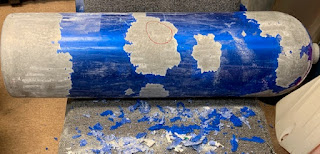The Wonder Breathing Gas - Trimix
Helium from a tidally shredded star being expelled from a black hole
Credit: NASA; S. Gezari, The Johns Hopkins University; and
J. Guillochon, University of California, Santa Cruz
Fred Stratton
Instructor and Technician
fred@bubblesornot.com
fred@bubblesornot.com
TECHNICAL DIVING SERIES PART IV
 |
| Helium's atomic weight and number Credit: Greg Reese on Pixabay |
Astronomers discovered helium by noting a yellow spectral line signature during a solar eclipse in 1868 and named it after Helios, Greek god of the sun. Helium is the second most abundant element in our universe after hydrogen although it is rare on Earth comprising only 0.0005% of planet's atmosphere. Helium is obtained primarily from underground deposits in Oklahoma, Texas and Kansas.
 |
Add helium to oxygen and nitrogen and
you get Trimix (He, O2, N2)!
Photo: PADI
|
As we descend beyond 165' (50m) elevated partial pressures of oxygen (PPO2) become a concern due to the risk of central nervous system (CNS) oxygen toxicity. Using helium to displace some nitrogen enables us to reduce our equivalent narcotic depth (END) to less than 130' (40m). Blending a hypoxic mix - less than 21% oxygen - we drop our PPO2, thus reducing the potential for CNS O2 toxicity.
A few people still dive to 200' (62m) and deeper on air...but why risk severe narcosis and CNS dangers when learning to plan and execute deep adventures with trimix awaits you at Bubbles or Not. Welcome to the Tec Trimix 65 course.
PADI TEC TRIMIX 65 COURSE
 |
| Carrying around 1,600 cubic feet of gas, (L-R) Dan, Dom, JD and Bob are well provisioned for a deep technical dive Photo: Rose Bennett |
Trimix 65 qualifies you to:
- conduct open circuit dives on trimix with 18% or more oxygen to a max depth of 210' (65m) with a PPO2 of 1.4 or less and an Equivalent Narcotic Depth (END) of 130' (40m).
- use two decompression gases / cylinders for trimix dive
Using Trimix to get your Deep Fix
 |
| USS ORISKANY conducting flight operations in 1955 Photo: US Navy |
Now what we are Trimix 65 certified and have experience diving to 210 feet we can explore the entirety of the ORISKANY down past the hangar bay and gun emplacements to the giant propellors and the keel! It will take dozens of dives to grow weary of this glorious warship.
 |
| Properly labeling scuba cylinders is an unbreakable rule when diving any gas other than air Photo: Fred Stratton |
The Jodrey sank on 21 November. All hands safely went ashore. The Jodrey rests in 254' (77m) while her bow starts at 145' (45m). This is a spectacular technical dive on a historical wreck that rests at an angle akin to an air-to-air missile on a launcher; most wrecks rest horizontally.
 |
| U.S. Navy carrier aircraft decimating the Japanese Fleet during Operation Hailstone Credit: US Navy photographer aboard USS Intrepid (CV-11) National Archives photo 80-G-215151 |
The Pacific paradise of Chuuk (Truk) Lagoon was the scene of Operation Hailstone which sank dozens of Imperial Japanese ships in February 1944. The San Francisco Maru's deck starts at 158' (48m) and entices divers with war relics such as sea mines, tanks, artillery shells, torpedoes, beer bottles and porcelain.
Construction equipment rests next to the hull at 205' (62m) making the San Francisco Maru a perfect Trimix 65 site to explore.
The government of the Federated States of Micronesia forbids artifact retrieval from these war wrecks. The ships appear as they were sunk 75 years ago, a time capsule of great loss for Japan and an American success toward ending a global conflict.
What You'll Learn and Do during Tec Trimix 65
 |
| 100% O2 enables accelerated decompression at 20' (6M) and 10' (3m) stops and requires O2-cleaned regs Photo: Dive Rite |
Practical Applications
- Check diver equipment configurations
- Establish a spirit of team building and comraderie
- Develop fluency with using multi-gas planning software
- Build upon mission planning skills learned and practiced in the Tec Deep Diver Course
- Build planning skills for Trimix dives including detailed mission planning
- Plan dives that include accelerated decompression
- Final dive planning will be the students' responsibility with staff oversight and assistance
Five Open Water Dives
- Dive 1: max depth of 30' (9m)
- Dive 2: between 90' (27m) and 165' (50m)
- Dive 3: between 100' (30m) and 165' (50m)
- Dive 4: between 100' (30m) and 185' (56m)
- Dive 5: between 150' (65m) and 210' (65m)
- Normoxic accelerated decompression
- Respond to a runaway low pressure inflator
- Simulated loss of deco gas
- Descent check
- Conduct long hose swim with buddy
- Remove & replace deco bottles without a mask
- Respond to an unresponsive breathing diver at surface
- Valve shutdown & regulator switch to address freeflowing regulator
- Primary BCD failure, neutral buoyancy with backup system
- Deploy lift bag or delayed surface marker buoy (DSMB)
- Switching gases using multi-gas computers
- Gas/depth/time awareness - record depth, time & SPG reading each 15 minutes throughout the dive
- Gas switch to O2 at 20' (6m)
- Air break - switch from deco mix to back gas then back to deco mix
- Post-dive review and critique
To Enroll in Tec Trimix 65 You Will Have
- Earned your Tec 50 Diver certification
- Logged at least 100 dives
Additional Reading
Years before Trimix, divers experimented with a helium-oxygen mix. Divers used Heliox for the first time in 1925 to investigate why the 280-foot steamship the Lakeland sank in Lake Michigan during a winter storm. Read about the Wreck of the Lakeland and the Birth of Mixed-gas Diving in DAN's Alert Diver magazine.
Coming in July: Manmade Scuba Playgrounds





Comments
Post a Comment